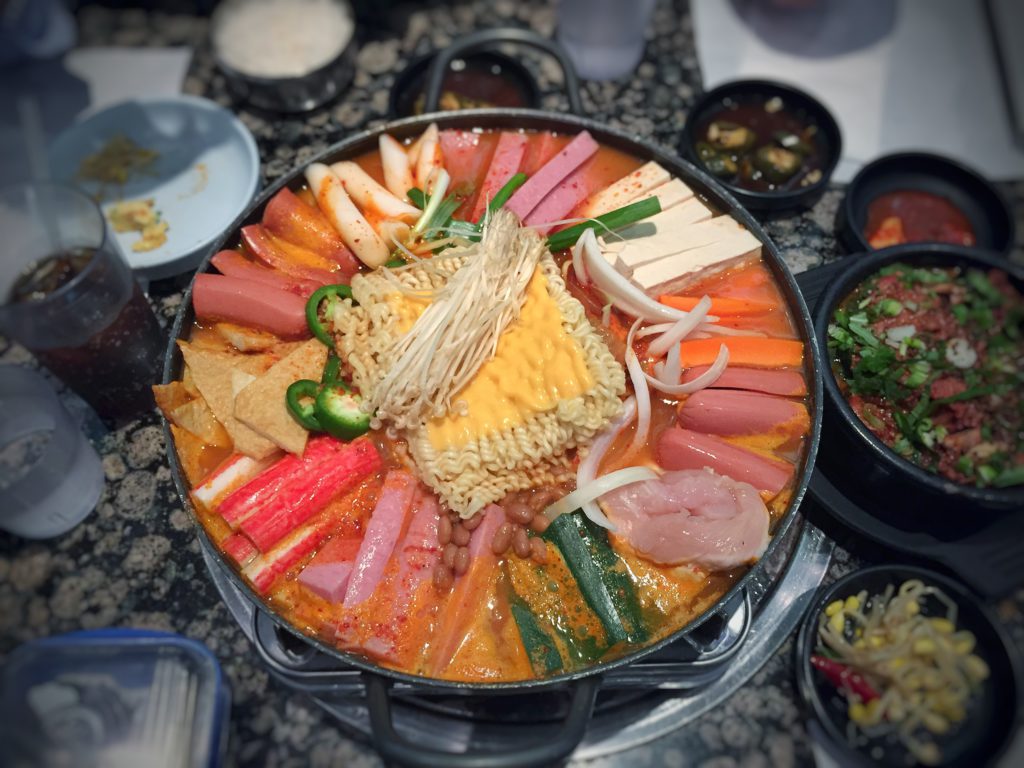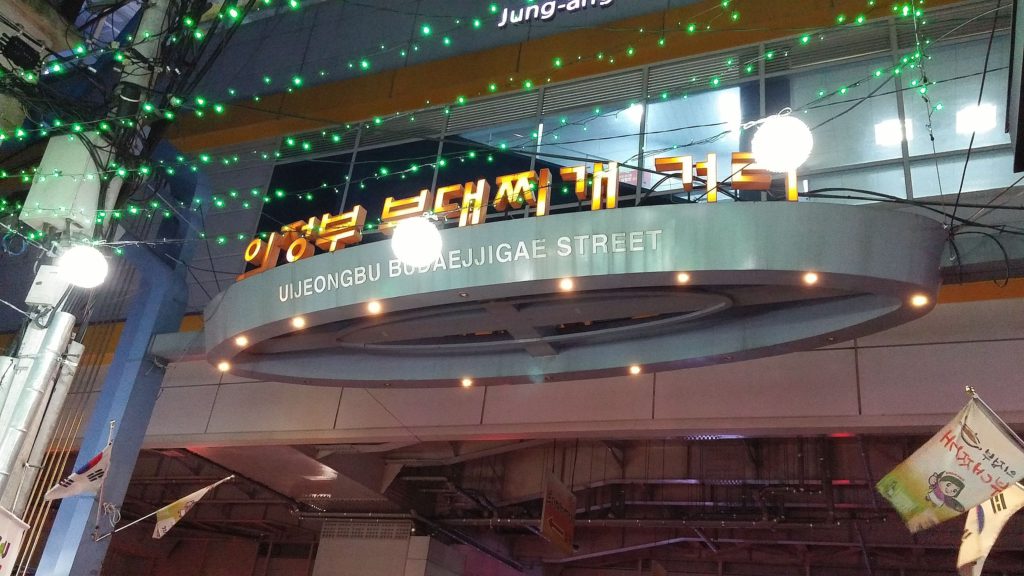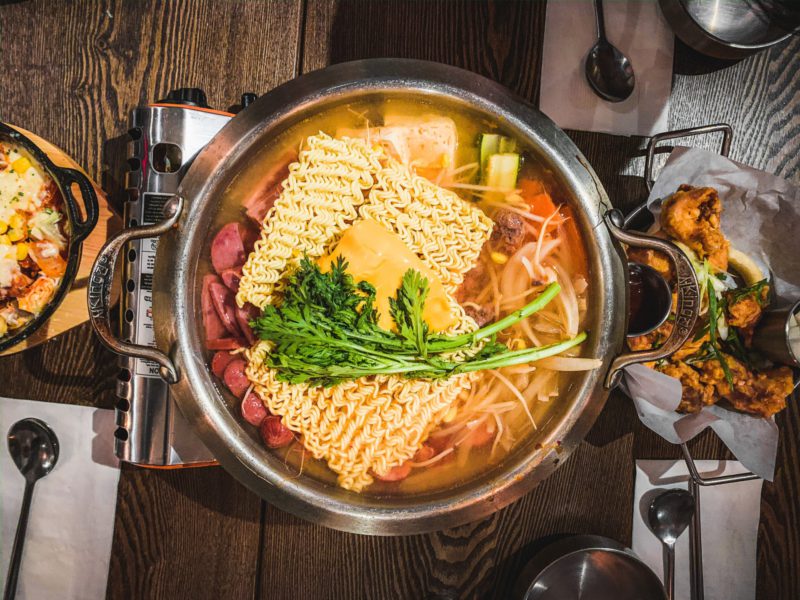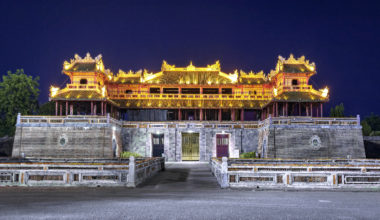Ever wondered about the origin of your favorite Korean stew, budae jjigae? From American spam to Korean fish cakes, the unlikely pairing of Western and Korean ingredients in budae jjigae has captured the world by storm. Trace the origins of this delicious dish and read on to explore Uijeongbu, the birthplace of budae jjigae.
Uijeongbu
Uijeongbu is a city in Gyeonggi, 20 kilometers north of Seoul. With popular nature attractions like the impressive Suraksan and the sprawling Bukhasan National Park, Uijeongbu is frequented by many from the Seoul Metropolitan Area looking for a nature getaway. This unassuming city is also the birthplace of one of South Korea’s most beloved comfort foods, budae jjigae. Read on to discover the sights and sounds of Uijeongbu with our ultimate guide to the city.
About budae jjigae

Budae jjigae, or “army base stew,” hails as one of South Korea’s most popular dishes. This hearty and thick soup combines Western meats of hot dogs, sausages, spam, and traditional Korean ingredients such as kimchi, red chili paste, and vegetables, to create the perfect combination of flavors. In addition to the mouthwatering mishmash of Western and Korean elements, the stew is topped off with instant ramen noodles and other foods like baked beans, American cheese, Korean fish cakes, and tofu, depending on preference. Often served in a large sharing pot, this fiery stew is an absolute delight to enjoy with friends and family.
The history of budae jjigae
The origins of budae jjigae trace back to after the Korean War in 1953. At the time, food in South Korea was scarce and many struggled to find ways to acquire food for their daily meals. One method the locals devised was to smuggle food, mostly leftover meat, out of U.S. Army bases located in Uijeongbu. These meats supplemented and added nutritional value to their traditional Korean meals. Eventually, this unlikely combination stuck, giving rise to the hearty budae jjigae we know and love today.
Getting to and around Uijeongbu
Getting to the city
Uijeongbu is very accessible and affordable to reach from the city of Seoul.
By subway
Take Subway Line 1 from central Seoul and alight at Uijeongbu station. The journey takes about 40 minutes.
By airport bus
Three different bus routes operate from Incheon International Airport to Uijeongbu. They are Airport-Dongducheon, Airport-Uijeongbu, and Airport-Jeongok.
Getting around the city
By metro
The U-line is Uijeongbu’s metro system that covers most areas around the city. We recommend this mode of transportation as it is cheap, efficient, and convenient.
By bus
If you’re looking to explore slightly beyond the city, taking a bus is the most cost-effective way to get around. Three different kinds of extensive bus routes cover north-eastern Gyeonggi-do. They are the Ilban Bus, Jwaseok Bus, and the Maeul Bus.
Exploring Uijeongbu
Eat your way through Budaejjigae Street

Uijeongbu has an entire street named after its famous dish, budae jjigae. Budaejjigae Street is home to more than 20 budae jjigae restaurants serving up authentic and mouthwatering army base stew.
Korea’s first budae jjigae restaurant, Odeng Sikdang, is located right here on Budaejjigae Street. Many restaurant owners claim that Odeng Sikdang’s founder, Heo Gi-suk, first invented budae jjigae at her humble street food stand when a Korean soldier approached her to cook for a nearby U.S Army base. Her budae jjigae was a hit among many, and with business booming, she opened Odeng Sikdang. Today, Odeng Sikdang continues to be very popular with snaking queues of visitors eager to get a taste of this famous dish.
Getting there: Take the 72-3 bus from the Uijeongbu Bus Terminal, Sindo Branew Apartment and alight at Uijeongbu Bubudae Jjigae Street.
Discover over 600 different stalls at Uijeongbu Jeil Market
Located near Uijeongbu Station, Uijeongbu Jeil Market is a traditional market that boasts over 600 different stalls. From traditional Korean side dishes to your daily grocery needs, this shopping heaven is stocked with a wide range of products.
This market is also a treasure trove of Uijeongbu’s best Korean street food. We recommend trying the chewy and spicy tteok-bokki (spicy rice cakes) when you visit the market. If you’d like to recreate this Korean dish at home, read our guide to the top 10 Korean street food recipes that you can make at home.
Getting there: Uijeongbu Jeil Market is located within a five-minute walk from Uijeongbu
Station, Dongbu Plaza.
Stroll through the Insta-worthy Yangju Nari Park
Widely regarded as one of the most beautiful parks in South Korea, the Yangju Nari Park is a breathtaking floral landscape that all nature lovers must visit. The park is home to a host of plant varieties, including muhly grass, a tall perennial plant with feather-like flowers that sets the park ablaze with ethereal colors of pink and lilac. The best time to catch sight of this pink paradise is from mid-September to November yearly.
Getting there: From the Uijeongbu Intercity Bus Terminal, take bus 207 to Kumo Elementary School. Transfer to bus 118 and alight at Meruji Village where you can take a five-minute walk to Yangju Nari Park. The entire journey will take about 30 minutes.
Visit Korea’s most popular hiking destination, Bukhasan National Park
If you’re looking to escape the city’s hustle and bustle, head to Bukhasan National Park. Over five million rock climbers and avid hikers visit the park annually, listing Bukhasan National Park in the Guinness Book of World Records as the “Most Visited National Park per Unit Area.” The park features hiking trails of varying difficulties, suitable for all levels, from the leisure hiker to the avid expert mountain climber. Immerse yourself in the park’s magnificent gorges, granite-top mountain peaks, and historical relics that dot the mountain trails.
Dobongsan
For dramatic mountainous sceneries, hike to the peak of Dobongsan, Seoul’s second-highest mountain at 739.5 meters. Various hiking trails are available here for hikers with different skill levels or those who can afford more time. Your journey first begins at Dobongsan’s unmissable trailhead after you’ve exited Dobongsan Station. Find an impressive number of Korean street food stalls, home-style restaurants, and even makeshift hiking stalls set up at the trailhead to cater to all your needs. The main climb that most people attempt will take three hours for a round trip.
Mangwol Temple
If you’d like a challenge up Dobongsan, take the Mangwol Temple trail to see one of Uijeongbu’s oldest temples. Considered an important monastery of Dobongsan, the captivating Mangwol Temple dates back to 639 and is used today as a meditation center. This route requires an extra hour and features an exhilarating ridge walk on the granite peak of Dobongsan. Grab on tight! The ridge can be slippery and dangerous due to weather conditions.
Getting there: Make your way on Subway Line 1 from Uijeongbu Station to Dobongsan Station. This journey will take you slightly less than 10 minutes.
Hike to the peak of Suraksan
This quieter alternative to Dobongsan is a hidden gem only locals know! Suraksan is a 638-meter-tall mountain that borders the northeast of Seoul and Uijeongbu. Not to be confused with Seoraksan, a popular national park located on the east coast of South Korea, this underrated hiking destination is as rewarding as some of the more popular mountains in the region. Find your peace here in the tranquil forest surroundings, pristine waterfalls, and serene temples as you enjoy your hike away from the crowds.
Getting there: Make your way on Subway Line 1 from Uijeongbu Station to Dobongsan Station. Alight and transfer to Line 7호선 to Suraksan Station. The entire journey will take you slightly less than 30 minutes.
About TourHero
TourHero is a social travel platform that enables you to travel with like-minded people and fall in love with the journey. We work closely with handpicked local operators to ensure every experience curated is unique and exclusive to your travel group. Come with us on epic adventures and create memories that last a lifetime!










